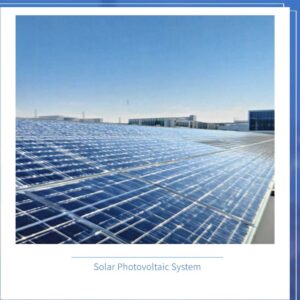You might wonder how much you will pay for a solar shingle roof. In 2024, the cost of photovoltaic shingles usually falls between $21 and $25 per square foot, with many homeowners spending $35,000 on average. For a typical 2,000-square-foot roof, you may expect to pay $40,000 to $50,000. The cost of photovoltaic shingles depends on your roof size, the type of shingle you choose, labor costs, and local incentives. Prices can also change if your roof has a complex shape or needs extra preparation.
Principaux enseignements
- Photovoltaic shingles cost $21 to $25 for each square foot. The total cost to install them is $21,000 to $99,500. The price depends on how big and complex your roof is.
- Incentives like the federal solar tax credit can lower your first costs. This makes solar shingles easier to afford.
- Solar shingles can make your home worth $15,000 to $30,000 more. This makes them a good choice if you want to sell your house later.
- You need to clean and check your solar shingles often. This helps them work well and last 25 to 30 years.
- Get quotes from different installers and look up local incentives. This helps you save money and choose the best option.
Cost of Photovoltaic Shingles
Price Per Square Foot
Photovoltaic shingles can cost a lot or a little. Most brands sell them for $10 to $35 per square foot. The price changes based on the brand, where you live, and who installs them. Some top brands cost more because they use better technology or last longer.
- Tesla Solar Roof costs about $62 for each square foot. This is much more than other brands.
- CertainTeed and GAF are cheaper. They usually cost $21 to $25 per square foot.
- If your roof is shaped in a tricky way or needs extra work, the price can go up.
Here is a table that shows how prices change in different places and with different brands:
| Region | Price per Square Foot (USD) | Notes |
|---|---|---|
| California | $21 – $25 | Prices are higher because of demand and labor. |
| Other Regions | Varies a lot | Local labor and rules change the price. |
| Premium Brands | More expensive than regular brands | They work better and last longer. |
If you pick a fancy brand or live somewhere with high labor costs, you will pay more for photovoltaic shingles.
Total Roof Cost
The total price for photovoltaic shingles depends on how big and complicated your roof is. Most people pay between $21,000 and $99,500 for a whole roof. For a roof that is 2,000 square feet, the average cost is $40,000 to $50,000. If you pick a Tesla Solar Roof, it can cost up to $106,000.
- GAF solar shingle systems cost $17,000 to $25,000 for everything.
- Bigger roofs need more shingles and more work, so they cost more.
- Roofs with lots of corners or special shapes are harder to install and cost more.
Note: Roofs can be simple, intermediate, or complex. Simple roofs are cheaper to cover with solar shingles. Complex roofs take more time and skill, so they cost more.
Cost Comparison
You might want to know how photovoltaic shingles compare to other roofs and solar choices. Photovoltaic shingles cost more than regular solar panels and asphalt shingles. But they work as both a roof and a solar system, so they can be a good idea if you need a new roof.
| Roofing Type | Cost Range |
|---|---|
| Photovoltaic Shingles | $20,000 – $100,000 |
| Panneaux solaires traditionnels | Cheaper than shingles |
| Asphalt Shingle Roofing | Costs less than solar roofs |
- Solar shingles cost more at first than regular solar panels.
- If you need a new roof, solar shingles might save you money because they do two jobs at once.
It takes longer to earn back the money you spend on photovoltaic shingles than with regular solar panels. Most people get their money back in 15 to 20 years with solar shingles. With regular solar panels, it takes 6 to 10 years.
| Type of Solar Technology | Coût initial | Payback Period |
|---|---|---|
| Panneaux solaires traditionnels | Plus bas | 6 to 10 years |
| Photovoltaic Shingles (Tesla) | Plus élevé | 15 to 20 years |
When you think about the cost of photovoltaic shingles, remember to look at how much energy you will save and how nice it is to have a modern roof.
Cost Factors
Roof Size
The size of your roof affects the total cost. Bigger roofs need more shingles and more work. This makes the price go up. Smaller roofs use fewer materials, so you pay less. Measure your roof before you plan your solar project.
Shingle Type
There are different kinds of solar shingles. Each brand gives a different amount of power and costs a different price per watt. Here is a table to help you compare:
| Solar Shingle Brand | Output (per shingle) | Cost (per watt) |
|---|---|---|
| Tesla Solar Roof | 72 W | $1.80 + roof replacement |
| GAF Energy | 45 W | $4.00 – $4.25 |
| Luma Solar | 80 W | $4.50 |
| CertainTeed | 70 W | $3.00 – $6.00 |
| Suntegra | 114 W | $4.00 – $6.00 |
Solar shingles last about 25 to 30 years. Most work at 10-20% efficiency, which is less than regular solar panels. You get a strong roof, but you might need more shingles to make enough energy.
- Solar shingles last 25-30 years.
- They do not work as well as regular solar panels.
- Their lifespan is like other good roofing materials.
Labor
Labor costs change based on your roof’s shape and the installer’s skill. Roofs with lots of corners or slopes need more time and effort. This makes the job cost more. Picking a certified installer helps you avoid mistakes and extra charges.
Permits
You need permits before you put in solar shingles. Most cities ask for a building permit and an electrical permit. Some places have a special solar permit that covers both. Here is a table showing common permits and their costs:
| Permit Type | Description | Average Cost Range |
|---|---|---|
| Building Permit | Checks roof safety and code compliance | $150 – $400 |
| Electrical Permit | Checks wiring and electrical safety | $150 – $400 |
| Dedicated Solar Permit | Combines building and electrical permits | Varies |
| Grid Connection Approval | Needed to connect to the power grid | Varies |
Incentives
The federal solar investment tax credit will end after 2025. You may also get state, local, or utility incentives, depending on where you live.
You can save money on photovoltaic shingles by using incentives. The federal tax credit, state rebates, and utility programs help lower your costs. Some places offer net metering, so you earn credits for extra power you send to the grid.
| Type of Incentive | Impact on Cost |
|---|---|
| Local Incentives | Lower the starting cost of solar roof shingles |
| Federal Tax Credit | Can be used with other incentives to save money |
| Utility Rebates | May lower federal tax credit value but add savings |
Installation Steps
Assessment
Before you put in photovoltaic shingles, you need to check your roof. First, sign a contract and set up a visit. A professional will come to your house. They will measure your roof and look at its shape. They also check for any damage or weak spots. Your roof must be strong enough for the new shingles. Here are the main things to do:
- Measure the roof and see its shape.
- Look for shade from trees or buildings.
- Hire a licensed contractor or engineer to find hidden issues.
- Test if your roof can hold the shingles.
A good check helps you avoid problems later.
Preparation
You have to get your roof ready before adding solar shingles. Start by checking how old your roof is and if it has leaks. If you find problems, fix them now. Clear away branches or anything that blocks sunlight. Sometimes, you need to make your roof stronger. Make sure you have all the right permits from your city.
- Fix broken shingles or leaks.
- Cut back trees that block the sun.
- Add support to the roof if needed.
- Get the needed permits.
Tip: A clean and strong roof helps your solar shingles last longer and work better.
Installation
Now you can start putting on the shingles. Installers place them at the best angle for sunlight. They use the sun’s winter position to decide the angle. In windy places, they use rails to keep shingles safe and stop leaks. Flat roofs may need special supports. Rows are spaced so rain can wash away dirt. Installers try not to make mistakes like crooked shingles or messy wires.
- Set the angle for the best sunlight.
- Use rails or supports to keep shingles safe.
- Space shingles so they are easy to clean.
- Check that shingles and wires are lined up right.
Electrical
After the shingles are on, connect them to your home’s power. Most homes need a 200-amp panel. Old homes might need a new panel. Electricians run wires through the roof and make sure everything is safe.
- Upgrade your panel if you need to.
- Put in new wires and grounding.
- Connect the system to your home’s power.
Inspection
When everything is done, inspectors check the work. They look at your permits, equipment, and safety. Inspectors make sure your system matches the plans and follows all rules. You need a final check before you can use your solar shingles.
| Inspection Area | Key Points |
|---|---|
| Permits & Documentation | Approved plans, datasheets, load numbers, permit copies, utility approval |
| Design & Installation Compliance | Shingles, inverters, layout match plans; fire access kept open |
| Electrical Compliance | Disconnects, wiring, grounding, labels follow rules |
| Roof & Structural Safety | Flashings sealed, panel space, roof strength checked |
| Unpermitted Work | Inspectors report any changes not approved |
| Final Inspection | Schedule city and utility checks; get Permission To Operate (PTO) |
Note: You must pass inspection before you can use your new solar roof.
Ongoing Costs
Maintenance
You need to keep your photovoltaic shingles clean. Dirt, leaves, and bird droppings block sunlight. This makes your shingles work less well. Check your roof every few months. Use a soft brush or water to clean them. Cut back trees and bushes so they do not shade your roof. Most people get a professional to check their roof once a year. This helps you find small problems before they get worse. Taking care of your roof helps it last longer and work better.
Tip: Clean your shingles in the morning or late afternoon. This stops streaks and keeps you safe from hot surfaces.
Repairs
Sometimes, photovoltaic shingles need to be fixed. You might see cracked panels or broken shingles. Wires can get loose or chewed by animals. Bad weather can cause rust. If your energy drops, look for damage. Here is a table that shows common repairs and what they cost:
| Type of Repair | Average Cost |
|---|---|
| Cracked panel | $120–$550 |
| Broken panel | $200–$550 |
| Loose or chewed wiring | $100–$400 |
| Rust and corrosion | $150–$350 |
| Solar inverter replacement | $150–$3,000 |
| Battery | $300–$15,000 |
| Fuse | $100–$150 |
Fix problems quickly so they do not get worse. Some repairs cost a lot, like batteries or inverters. Small repairs do not cost much. If you take care of your roof, you will need fewer repairs.
Monitoring
You can watch how your photovoltaic shingles work with a monitoring system. Many solar roofs have apps or online dashboards. These show how much energy you make each day. Check your system often to find problems early. Here are some good ways to monitor your solar roof:
- Check your solar panels often to help them last.
- Measure important numbers to see how your system works.
- Look at your roof to find damage or dirt.
- Clean panels and cut plants yourself.
- Get a professional to check your roof sometimes.
If you do these things, your solar roof will work well. Monitoring helps you find problems early and save money. You will get the most out of your solar roof.
Financing and Incentives
Loans
There are many ways to pay for a solar shingle roof. Banks and solar companies give loans just for solar projects. If you own your home, you can use a home equity loan or a line of credit. Some cities let you pay for solar with your property taxes using PACE loans. Utility companies sometimes have special loans with low interest. You can also pick a solar lease or a power purchase agreement (PPA) if you do not want to own the system. These choices help you pay over time and make solar less expensive.
| Loan Type | Description |
|---|---|
| Solar Loans | Loans made for solar panel projects. |
| Home Equity Loans (HELOC) | Credit from your home’s value, often with lower interest. |
| PACE Loans | Paid with property taxes, no credit score needed. |
| Solar Leases | Pay each month to use solar panels, but you do not own them. |
| Power Purchase Agreements (PPAs) | Pay for the energy you use at a lower price than your utility bill. |
| Personal Loans | Loans without collateral for people with good credit. |
| Utility Company Financing | Loans from utility companies, sometimes with little or no interest. |
| Local Grants and Incentives | Money from local governments to help pay for solar. |
You can also use federal programs like the FHA’s Solar and Wind Technologies program or the Energy Efficient Mortgage program. These programs let you add solar costs to your mortgage or refinance your home for energy upgrades.
Incentives
You can save money on your solar roof with incentives. The federal solar tax credit lets you get back 30% of your installation cost on your taxes. Many states and cities give rebates or grants for solar roofs. Utility companies may give you credits for extra energy you send to the grid. Some programs, like net metering, help you earn money back every month. Incentives are different in each place, so check what you can get where you live.
Tip: Apply for incentives before you start your project. This helps you save the most money.
ROI
You might want to know how long it takes to get your money back. Solar shingles usually pay for themselves in 8 to 12 years. Sometimes, you can get your money back in as little as 5 years or as long as 15 years. Regular solar panels cost less per watt and pay for themselves about 5 years sooner. Solar shingles can give you a return on investment between 50% and 80%. If you use incentives and pick the right loan, you can get your money back faster.
- Solar shingles: Payback time is 6 to 10 years.
- Traditional solar panels: Payback time is about 5 years.
- Solar shingles: Return on investment is between 50% and 80%.
You should think about your energy savings, incentives, and the total cost of photovoltaic shingles to see what works best for your budget.
Value and Benefits
Energy Savings
When you install photovoltaic shingles, you can save a lot on your energy bills. These shingles turn sunlight into electricity for your home. Many families see big changes in their monthly costs.
- In California, you could save about $200 each month on electricity after installing a $15,000 solar system. That adds up to $2,400 every year.
- In Ohio, a family who leases solar panels saves $600 each year by avoiding higher power bills.
- In New York, a couple saves $220 every month while paying off their solar loan. This means they save $2,640 each year.
You can use these savings to pay off your system faster or spend on other things you need. Over time, your energy bills will drop, and you will feel the difference in your budget.
Property Value
Solar shingles do more than lower your bills. They can also make your home worth more. Studies show that homes with solar shingles often sell for higher prices.
- Homes with solar shingles can see their value go up by $15,000 to $30,000.
- The size and efficiency of your solar system can change how much your home’s value increases.
- Buyers like homes with solar shingles because they save money and look modern.
If you plan to sell your home in the future, solar shingles can help you get a better price.
Environment
Photovoltaic shingles help protect the planet. They make clean energy and lower your carbon footprint. Once installed, they do not release any emissions, unlike regular roofs.
| Key Contribution | Description |
|---|---|
| Zero Emissions Energy Production | Solar shingles make electricity without greenhouse gases. |
| Reduced Air Pollution | They cut down on pollution from power plants that burn fossil fuels. |
| Less Dependence on the Grid | Using more solar energy means less need for fossil-fuel electricity. |
Solar shingles start with some carbon emissions from making and shipping them. However, they make up for this in just a few years by producing clean energy. When you choose solar shingles, you help reduce pollution and fight climate change.
You now know the main cost ranges and what affects the cost of photovoltaic shingles. The upfront price can be high, but you can lower it with tax credits and rebates. Here are some key points to remember:
- You may pay more at first than with regular roofs.
- Incentives like a 26% federal tax credit and local rebates help reduce your costs.
- Solar shingles can raise your home’s value by up to 4% or $6,000 per kilowatt.
- You gain energy savings and a modern look for your home.
Get quotes from several installers and ask about all available incentives. This helps you make the best choice for your budget and long-term savings.
FAQ
How long do photovoltaic shingles last?
Most photovoltaic shingles last 25 to 30 years. You get a strong roof and solar power for decades. Brands may offer warranties for 20 to 25 years.
Tip: Check your warranty before you buy.
Can you walk on solar shingles?
You can walk on some solar shingles, but you should avoid it. Walking may crack or damage them. Always ask your installer about safe roof access.
Do photovoltaic shingles work on cloudy days?
Photovoltaic shingles still make electricity when it is cloudy. You get less power than on sunny days. Your system works best with direct sunlight.
| Weather | Power Output |
|---|---|
| Sunny | 100% |
| Cloudy | 10–25% |
| Rainy | 5–10% |
What happens if a shingle breaks?
If a shingle breaks, you need to replace it. Call your installer for repairs. Broken shingles can lower your energy output and may cause leaks.
Note: Fix damage quickly to protect your roof and keep your system working well.

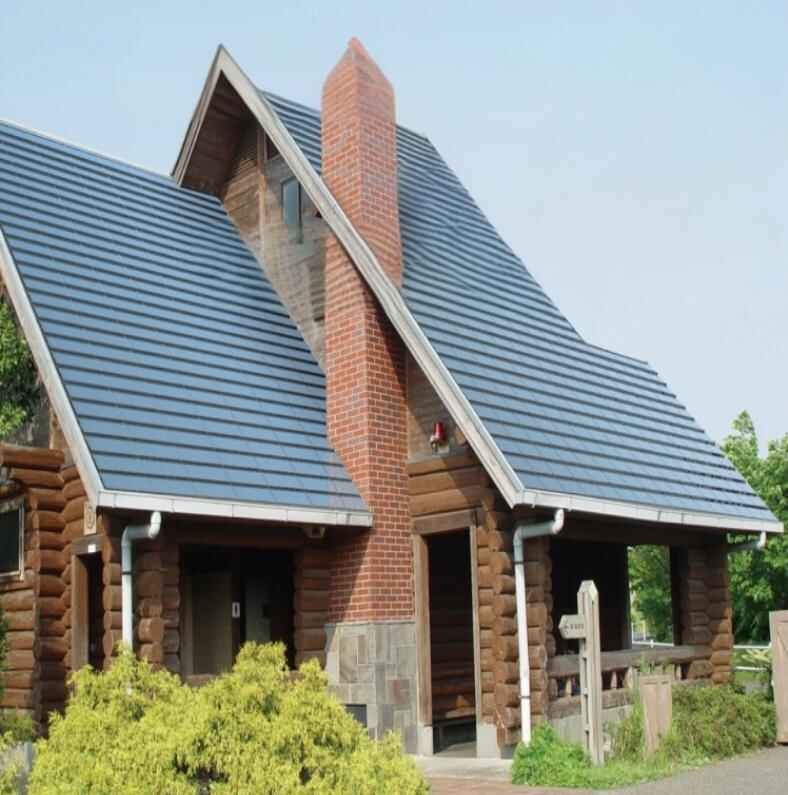
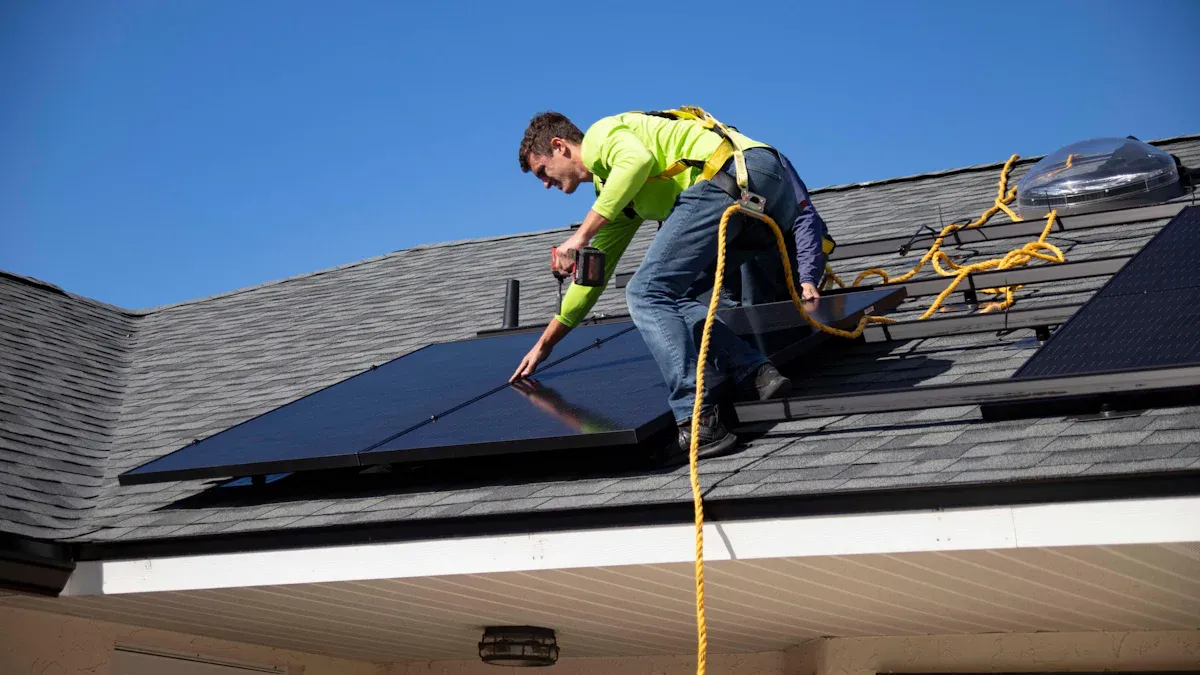
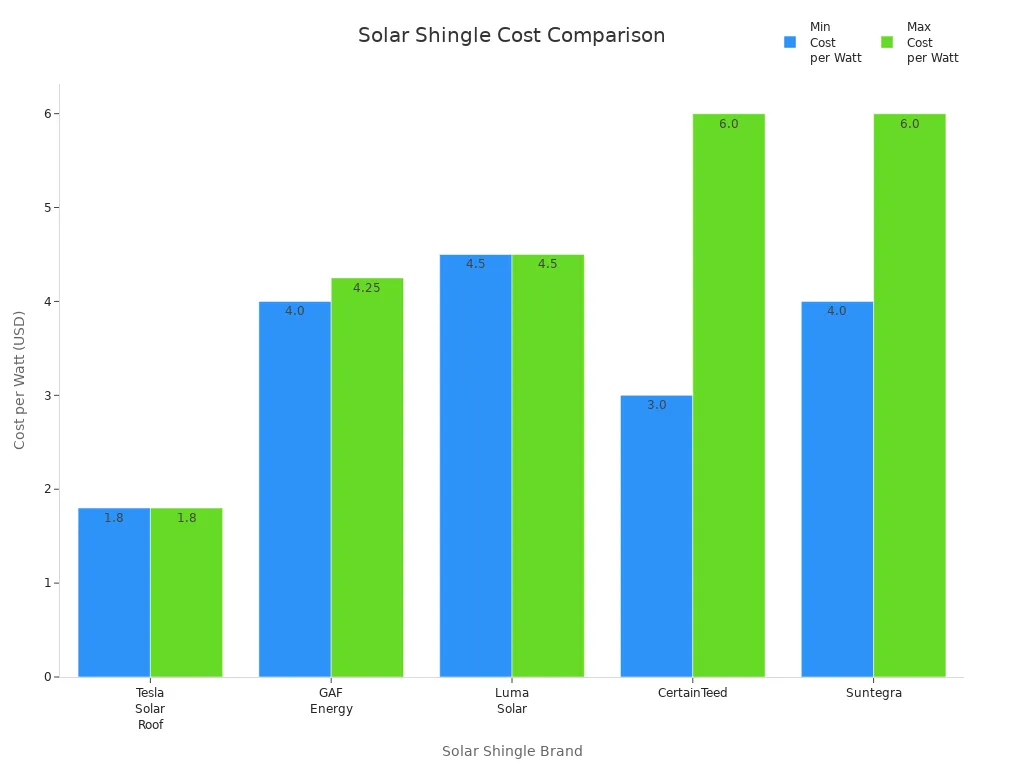
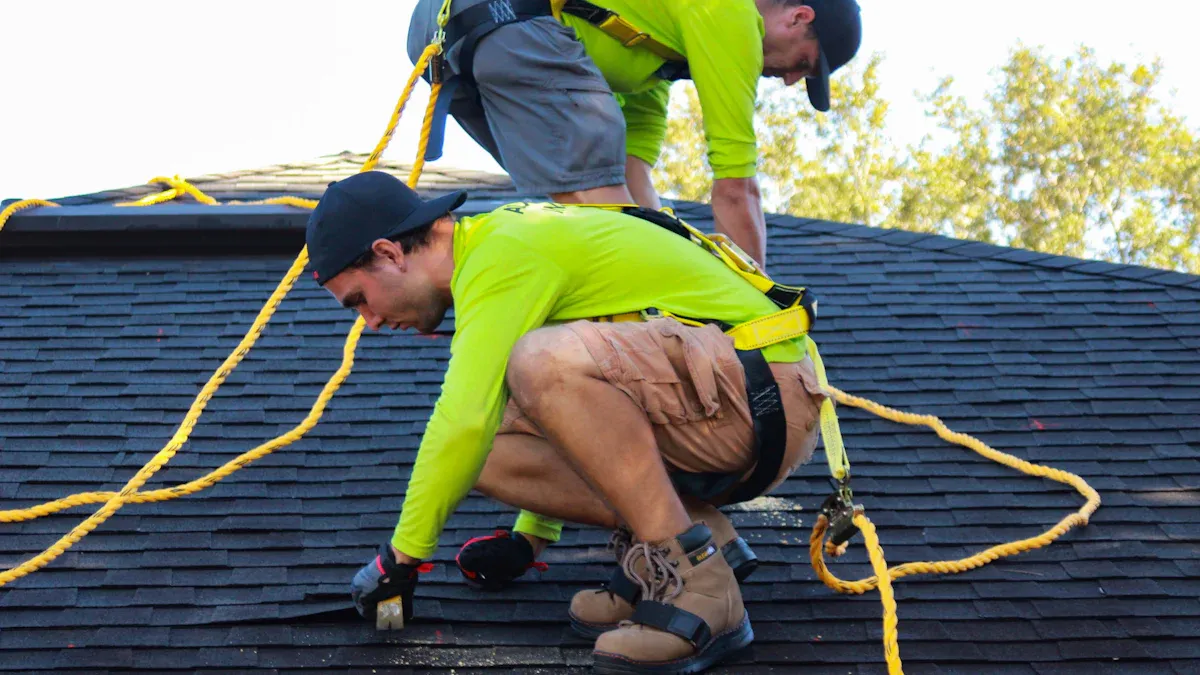



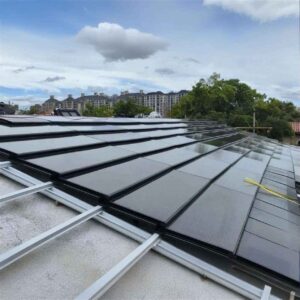
-300x300.jpg)
-300x300.jpg)





